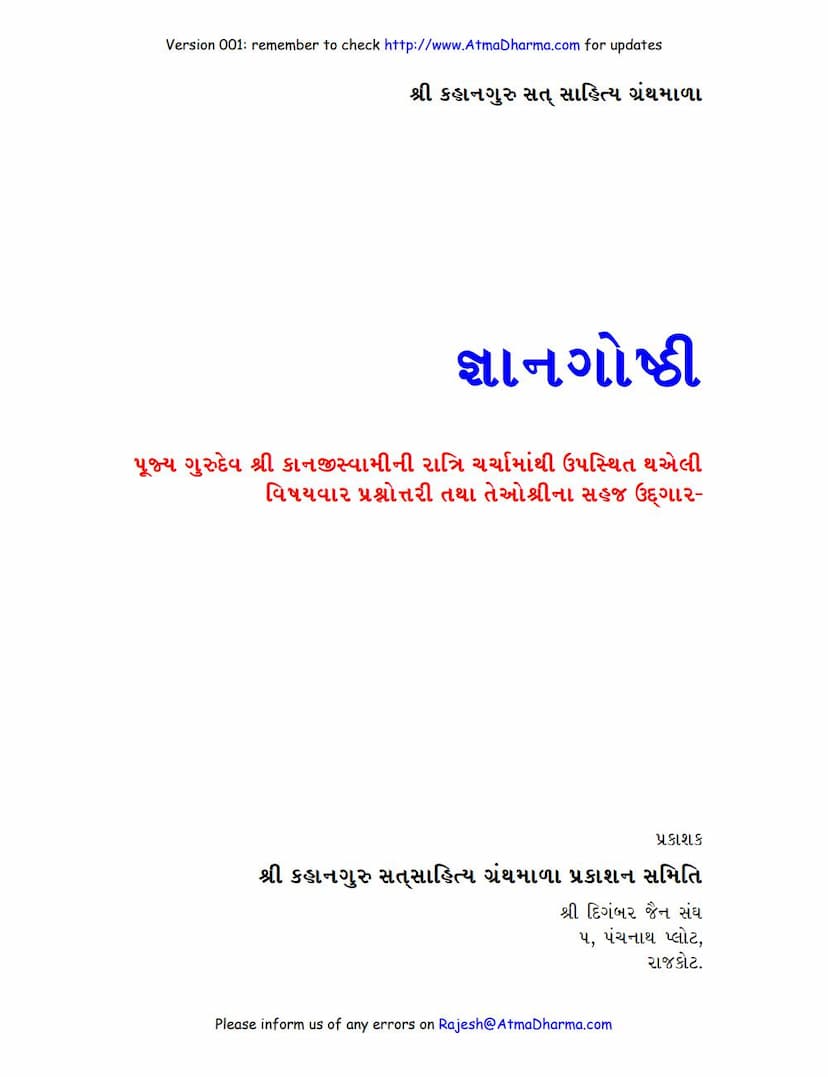Gyan Gosthi
Added to library: September 1, 2025

Summary
This Jain text, titled "Gyan Gosthi" (ज्ञानगोष्ठी), is a compilation of question-and-answer sessions featuring the teachings of Pujya Gurudev Shri Kanji Swami. The text, published by Shri Kahan Guru Sat Sahitya Granth Mala, presents a collection of profound discussions on Jain philosophy, primarily focusing on the nature of the soul (Atma), the path to liberation, and the understanding of core Jain principles.
The book is structured thematically, covering various subjects that arose during the night discussions (Ratri Charcha) between Kanji Swami and his disciples. These discussions, which took place over forty-five years, aimed to clarify intricate spiritual concepts in simple language, making them accessible to all seekers.
Here's a breakdown of the key themes and concepts presented in the text:
Core Themes:
- The Nature of the Soul (Atma): A significant portion of the text is dedicated to defining and understanding the soul. It is described as "Bhagwan Atma" (भगवान आत्मा) – the divine soul, which is eternal, pure, and beyond the influence of physical matter, karma, or worldly experiences. The soul's inherent nature is described as pure consciousness, knowledge, and bliss. It is emphasized that the soul is distinct from the body, senses, mind, speech, and even the changing states (Paryayas) of existence.
- Bhed-Vigyan (Discernment/Separation): A central concept discussed is "Bhed-Vigyan" (भेद-विज्ञान), the practice of differentiating the soul from all non-soul elements. This includes understanding that karma, emotions (like Raga-Dwesha), the body, and even subtle mental states are not the true nature of the soul. This discernment is presented as the path to self-realization.
- Samayakdarshan (Right Faith/Perception): The text extensively explains Samayakdarshan, which is the correct perception of reality, particularly the nature of the soul. It's not merely intellectual understanding but a deep-seated conviction and faith in the soul's inherent purity and eternal nature. The book clarifies that true Samayakdarshan arises from an inward focus and understanding of one's own true self, rather than external rituals or devotion to deities for worldly gain.
- Nischay and Vyavahar (Ultimate Truth and Conventional Truth): The discussions frequently touch upon Nischay Naya (ultimate perspective) and Vyavahar Naya (conventional truth). While Vyavahar is acknowledged as a stepping stone to understanding, the ultimate goal is to transcend it and rest in the Nischay perspective, which sees the soul as pure, eternal, and unchanging. For example, while actions might appear to be performed, the ultimate truth is that the soul is merely a witness (gyata) and not the doer (karta).
- Karma and Liberation (Moksha): The text addresses the workings of karma and how to achieve liberation. It stresses that liberation is not achieved through external actions or penances but through the direct experience of the soul's true nature. Understanding the soul's inherent purity and separateness from karma is the key to dissolving karmic bondage.
- The Role of Deva, Shastra, and Guru: The text discusses the importance of contemplating the true nature of God (Deva), scriptures (Shastra), and the spiritual preceptor (Guru). However, it emphasizes that these are not to be idolized or relied upon for external benefits. They serve as means to realize the soul's true nature. True devotion is internal, focused on the soul itself.
- The Nature of Knowledge (Gyan) and Experience (Anubhuti): The discussions clarify that true knowledge leads to direct experience (Anubhuti) of the soul. Intellectual knowledge (Shastra Gyan) alone is insufficient; it must culminate in self-realization.
- Subtle Teachings on Causation: The text delves into subtle explanations of causation, emphasizing that external factors are merely निमित्त (niimit) or 'enabling causes,' while the true cause (Upadan) lies within the soul itself. The soul's inherent nature and its own states are the ultimate drivers of its experiences.
Key Takeaways:
The "Gyan Gosthi" emphasizes a path of introspection and self-realization. The core message revolves around understanding the soul's pure, eternal, and blissful nature, distinct from all worldly phenomena and karmic forces. Kanji Swami's teachings, as presented here, aim to guide the seeker towards this realization through right faith (Samayakdarshan), right knowledge (Samayak Gyan), and right conduct (Samayak Charitra), all rooted in the direct experience of the soul. The book aims to dispel misconceptions and guide individuals towards the ultimate goal of liberation (Moksha) by focusing on the internal transformation of consciousness.